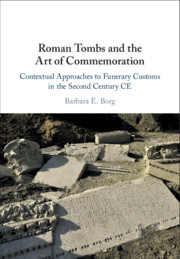 Roman Tombs and the Art of Commemoration
Roman Tombs and the Art of Commemoration Book contents
- Roman Tombs and the Art of Commemoration
- Roman Tombs and the Art of Commemoration
- Copyright page
- Contents
- Figures and Illustrations
- Preface
- Acknowledgements
- Abbreviations
- 1 In Search of Deceased Senators
- 2 Reviving Tradition in Hadrianic Rome: From Incineration to Inhumation
- 3 Family Matters: The Long Life of Roman Tombs
- 4 Straddling Borderlines: Divine Connotations in Funerary Commemoration
- Bibliography
- Index Nominum
- General Index
4 - Straddling Borderlines: Divine Connotations in Funerary Commemoration
Published online by Cambridge University Press: 01 April 2019
- Roman Tombs and the Art of Commemoration
- Roman Tombs and the Art of Commemoration
- Copyright page
- Contents
- Figures and Illustrations
- Preface
- Acknowledgements
- Abbreviations
- 1 In Search of Deceased Senators
- 2 Reviving Tradition in Hadrianic Rome: From Incineration to Inhumation
- 3 Family Matters: The Long Life of Roman Tombs
- 4 Straddling Borderlines: Divine Connotations in Funerary Commemoration
- Bibliography
- Index Nominum
- General Index
Summary
Information
- Type
- Chapter
- Information
- Roman Tombs and the Art of CommemorationContextual Approaches to Funerary Customs in the Second Century CE, pp. 191 - 290Publisher: Cambridge University PressPrint publication year: 2019